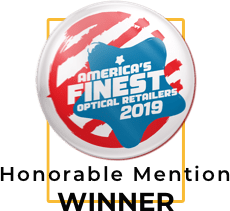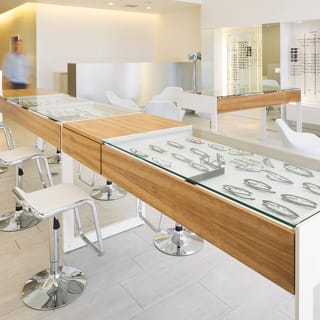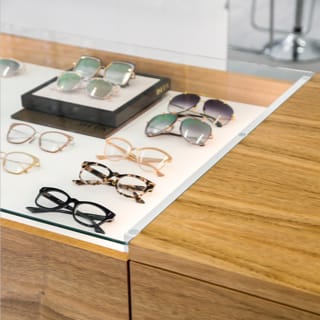If you find yourself squinting to read road signs or having trouble seeing distant objects clearly, you might be among those who are nearsighted. Fortunately, modern optics offer a variety of lens options to help you see clearly again.
Making the right choice can significantly enhance your vision and daily life. Types of lenses for nearsightedness include:
- Single Vision Lenses
- High-Index Lenses
- Aspheric Lenses
- Soft & Rigid Gas Permeable Contact Lenses
Let’s explore how each of these lenses can help correct nearsightedness and improve your quality of life.
Understanding Nearsightedness: Causes & Symptoms
Nearsightedness occurs when the eye is shaped in a way that causes light to be focused in front of the retina rather than directly on it. This issue usually arises from either:
- The eye being too long
- The cornea being too curved
Genetics often play a significant role, so if your parents are nearsighted, there is a higher chance that you may be as well.
Symptoms of nearsightedness include:
- Blurry vision when looking at distant objects
- Squinting
- Headaches
- Eye strain
These symptoms can affect day-to-day activities like driving, watching TV, or participating in sports.
Single Vision Lenses
Single vision lenses are a popular choice for correcting nearsightedness. They have a consistent prescription across the entire lens, making them simple yet effective.
These lenses are suitable for everyday activities and are available in various lens materials and treatments, such as UV protection, no-glare, and scratch-resistance.
Benefits
One of the main advantages of single vision lenses is their affordability. They provide clear vision at an affordable price, making them accessible to a wide range of people.
Additionally, they are easy to customize with various frame styles, allowing you to express your fashion sense while improving your vision.
High-Index Lenses
High-index lenses are a fantastic option for those with higher eyeglass prescriptions. These lenses are made from materials that bend light more efficiently, allowing them to be thinner and lighter than traditional lenses.
This makes them a comfortable and stylish choice for individuals with more severe nearsightedness.
Benefits
One of the key benefits of high-index lenses is their aesthetic appeal. Thicker lenses can be bulky, but high-index lenses maintain a sleek and thin appearance even with stronger prescriptions. This not only improves comfort but also boosts confidence in your eyewear.
In addition to their aesthetic advantages, high-index lenses also provide excellent optical clarity. They reduce the “Coke bottle” effect commonly associated with thicker lenses, ensuring a more natural and distortion-free vision.
This makes them an ideal choice for both daily wear and special occasions.
Aspheric Lenses

Aspheric lenses are designed with a more complex surface profile, which helps minimize distortions and aberrations. This advanced design ensures that light rays entering the lens are focused more accurately on the retina, providing clearer and sharper vision.
Benefits
One of the significant advantages of aspheric lenses is their ability to reduce the “fisheye” effect that can occur with traditional lenses. This effect is particularly noticeable with stronger prescriptions, where the edges of the lens can cause visual distortions.
Aspheric lenses eliminate this issue, ensuring a more natural and undistorted view. Furthermore, aspheric lenses are thinner and flatter than conventional lenses, making them more comfortable to wear.
They are also lighter, which reduces the pressure on your nose and ears, enhancing overall comfort.
Soft vs. Rigid Gas Permeable Contact Lenses
Contact lenses offer a convenient alternative to traditional eyeglasses for correcting nearsightedness. They sit directly on the eye itself, providing a wider field of vision and eliminating the need for bulky frames. There are two main types of contact lenses for nearsightedness:
- Soft lenses
- Rigid gas permeable (GP) lenses
Soft Contact Lenses
Soft contact lenses are made from flexible materials that conform to the shape of your eye. They are comfortable to wear and come in various disposable options, including:
- Daily
- Biweekly
- Monthly
Soft lenses are ideal for people with an active lifestyle, as they stay in place during physical activities and sports.
Rigid Gas Permeable (GP) Contact Lenses
Rigid gas permeable (GP) lenses, on the other hand, are made from durable materials that maintain their shape on the eye.
They provide crisp and clear vision, especially for people with higher prescriptions. GP lenses are also relatively more breathable, reducing the risk of eye infections and dryness.
Choosing the Right Lens for Your Lifestyle and Needs
Selecting the right lens for your nearsightedness involves considering various factors, including your lifestyle, visual preferences, and budget. Here are some tips to help you make an informed decision:
- Assess Your Daily Activities: Consider how you spend your day, including daily activities. If you have an active lifestyle, contact lenses might be a better option.
- Evaluate Your Prescription: The strength of your prescription plays a significant role in determining the type of lens that best suits your needs. High-index lenses are ideal for stronger prescriptions, while single vision lenses work well for mild-to-moderate myopia.
- Consider Aesthetics: If you prioritize aesthetics, high-index and aspheric lenses offer a thinner and more attractive appearance. These lenses ensure you look good while enjoying clear vision.
- Consult with an Eye Care Professional: Seeking advice from an eye care professional is crucial in making the right decision. They can conduct a thorough eye examination, assess your visual needs, and recommend the best lens options for you.
If you are ready to explore lens options for your nearsightedness, book an appointment with Eye Love Optometry today. We can guide you through the process and help you find the ideal lens solution for your visual needs.
















